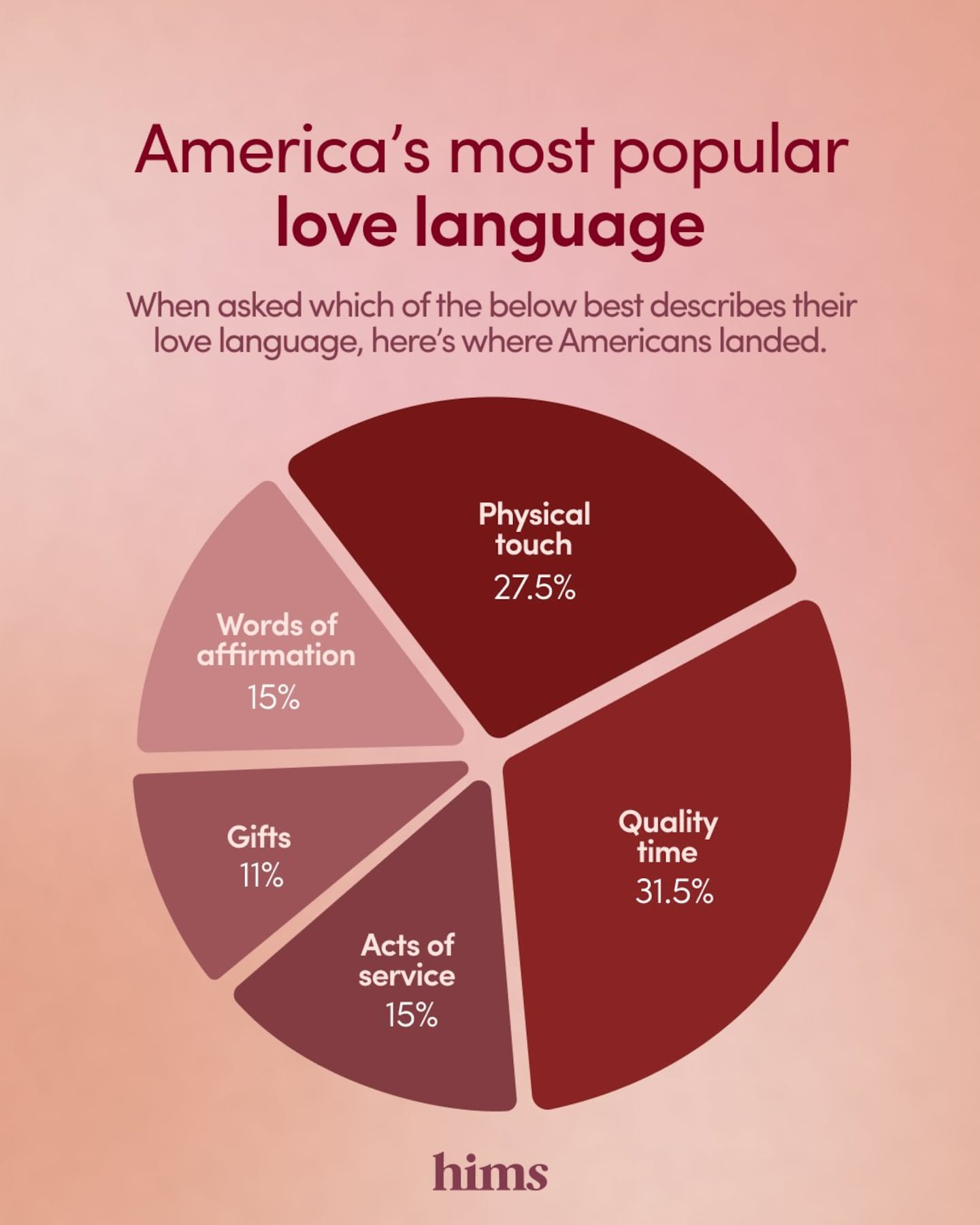This Valentine's Day, consider asking your partner, "What's your love language?"
The 5 Love Languages®—gift giving, quality time, words of affirmation, acts of service, and physical touch—were developed by Gary Chapman to help people strengthen connection in relationships.
Some people want to hear kind words, others want physical affection, and then there's those who just want a great gift (who says you can't buy love?). The problem is, oftentimes we speak in our own love language rather than our partner's.
Hims set out to discover which love language is the default of most Americans.
To make sparks fly, you don't need to learn French, but you do need to know the language of love. Here's which love languages resonate most in America, according to a 2025 Hims study, as well as tips for how to find which words and actions will resonate most with your special someone, whether it's a longtime lover or a V-Day fling.
What's the Most Popular Love Language in America?
Hims asked Americans which of the following best describes their love language: quality time, physical touch, acts of service, words of affirmation, or gifts. Here's what they had to say.
- Quality time (spending dedicated, focused time together with full attention): 31.5%
- Physical touch (showing affection through physical contact like hugs, kisses, and holding hands): 27.5%
- Acts of service (performing helpful actions for someone to demonstrate love): 15%
- Words of affirmation (expressing love through verbal compliments, praise, and positive affirmations): 15%
- Gifts (feeling loved by receiving thoughtful presents): 11%
Hims
Love Languages by Relationship Status
Whether your relationship is just getting started or is more serious and you're looking to rekindle—relationship status matters when it comes to the language of love.
Singles and married couples are actually very similar in their top love language: both disproportionately want quality time—34% of singles and 33% of married couples name quality time with a romantic partner as their top love language, as compared to just 28% of monogamous couples. This Valentine's Day, plan a kid- and phone-free romantic dinner to spend some quality time together (maybe trying some aphrodisiac foods to spice it up!).
What do monogamous couples want? Physical sparks to fly—30% of people in a committed relationship name physical touch as their language of love, as compared to 25% of singles and 28% of married couples.
Maintaining intimacy is important in any long-term relationship and it can be hard to keep it fresh and exciting (especially if you're dealing with any issues like erectile dysfunction, premature ejaculation, or low testosterone). Communicate with your partner to plan for some time to get physical this Valentine's Day.
Love Languages by Generation
Knowing the right generational lingo is as important on TikTok and Tinder as it is in IRL. Across the board, Gen Zs, Millennials, and Gen Xers all appreciated quality time the most, making it the top love language in America (32%).
However, Millennials—also known as the "me, me, me" generation—are more likely than their Gen Z counterparts to appreciate words of affirmation (16% vs. 13%) and less likely to romantically respond to acts of service (13% among Millennials vs. 16% among Gen Z) or gifts (also 13% and 16%, respectively). Take the time to write your Millennial lover a thoughtful card letting them know how you feel about them to show them how much you love and appreciate them.
Gen Xers, on the other hand, were the generation most likely to want to get physical (28%) and least likely to appreciate gifts (9%)—unless that gift is an act of service, which ranked high on Gen Xers' list of love languages (16.5%). So, instead of buying your Gen X-lover flowers, perhaps help plant trees in your community.
Love Languages by Orientation
Statistically speaking, the biggest demographic divide in love languages comes between heterosexual and LGBTQ+ respondents: 33% of heterosexual individuals prioritize the love language of quality time as compared to just 22% of LGBTQ+ respondents—a notable 10 percentage point difference.
Both groups responded similarly to the language of physical touch (the top love language for LGBTQ+ folks at 26% vs. 28% for heterosexual respondents), but that's where the similarities end. 20% of LGBTQ+ respondents appreciate acts of service, as compared to just 14% of heterosexual respondents; 19% of LGBTQ+ respondents appreciated words of affirmation vs. 14% of heterosexual respondents; and 14% of LGBTQ+ prefer gifts vs. 10% of heterosexual respondents.
Members of the LGBTQ+ community might want to plan a spicy date night to connect physically while also getting in some good quality time.
Love Languages by Music Taste
Music can also be a language of love, according to this study. If your partner likes K-pop, for example, they are the most likely of any music fan base to cherish quality time in their love life (37% vs. 32% among respondents overall).
Country fans, on the other hand, are quite the opposite: Only 27% want quality time; instead, 32% want physical touch as compared to just 24% of K-pop fans who feel the same.
So what about if your lover is into EDM? Give them a gift—maybe tickets to an upcoming show—15% of EDM fans say gifts are a way to their heart as compared to 11% of Americans overall.
Indie fans, not surprisingly, are looking for alternatives to the usual love languages, and were the most likely to opt for acts of service (17% vs. 15% overall) and words of affirmation (also 17% vs. 15%).
Interestingly, as different as hip hop fans and rock fans may seem to be, their romantic taste is nearly the same.
And if your lover is a pop fan, forget about friendship bracelets and prioritize quality time: 36% say it's their love language vs. 32% overall.
Communication is always key when it comes to having a healthy relationship and sex life, and learning more about how your partner likes to give and receive love is a great place to start the conversation.
Data and Methodology
This study is based on a 7,100-person online survey, which included (1) 5,000 18-to-65-year-old respondents in the top 50 metropolitan areas (100 respondents per city); (2) 5,000 18-65-year-old respondents in each of the 50 states (100 respondents per state); and (3) a nationally representative sample of 500 18-to-65-year-old respondents to contextualize results. These three categories are not mutually exclusive; some respondents fall within more than one category. The study was fielded in January 2025.
Findings were analyzed by 190 demographic and psychographic cuts, including city, region, gender (when we refer to "women" and "men," we include all people who self-identify as such), age, race and ethnicity, relationship status, parenting status, sexual orientation (heterosexual, bisexual, gay, lesbian, pansexual, asexual, queer, etc.), fandoms (music, sports, etc.), and fitness and diet preferences, among other areas of interest.
All data in this study are from this source, unless otherwise noted. Independent research firm, Culture Co-op, conducted and analyzed research and findings.
This story was produced by Hims and reviewed and distributed by Stacker.









